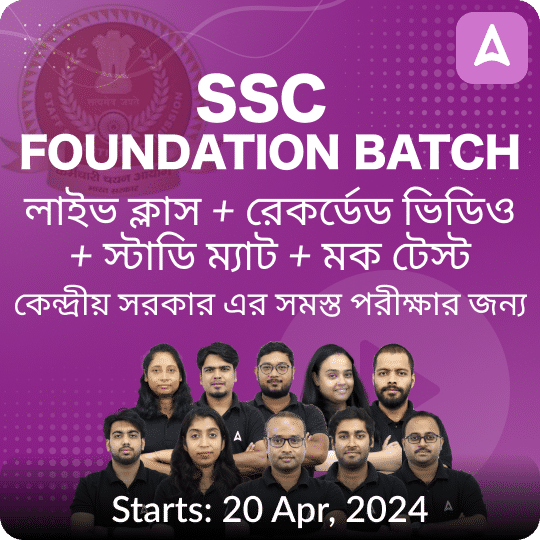Q1. সুপ্রিম কোর্টের বিচারক হিসাবে নিয়োগের যোগ্যতার মানদণ্ড সম্পর্কে নিম্নলিখিত বিবৃতিগুলি বিবেচনা করুন:
- তিনি পাঁচ বছরের জন্য হাইকোর্টের বিচারক হওয়া আবশ্যক।
- ভারতের ভূখণ্ডে দশ বছরের জন্য তার কোনও বিচারিক অফিস থাকা আবশ্যক।
- ভারতের রাষ্ট্রপতির মতামতে তাঁকে একজন বিশিষ্ট বিচারপতি হওয়া উচিত।
উপরোক্ত বিবৃতিগুলির মধ্যে কোনটি সঠিক / কোনগুলি সঠিক?
(a) 1 এবং 2
(b) 2 এবং 3
(c) 1 এবং 3
(d) সমস্ত
Q2. আইন কমিশন সম্পর্কিত নিম্নলিখিত বিবৃতি বিবেচনা করুন
- প্রথম আইন কমিশন 1833 সালের সনদ আইনের অধীনে লর্ড ম্যাকলের সভাপতিত্বে প্রতিষ্ঠিত হয়েছিল।
- বর্তমানে এটি সংসদের একটি আইন দ্বারা দুই বছরের জন্য সেট আপ করা হয়েছে।
উপরোক্ত বিবৃতিগুলির মধ্যে কোনটি সঠিক / কোনগুলি সঠিক?
(a) কেবল 1
(b) কেবল 2
(c) 1 এবং 2 উভয়ই
(d) কোনটিই নয়
Q3. বর্ডার রোড অর্গানাইজেশন (বিআরও) সম্পর্কিত নিম্নলিখিত বিবৃতিগুলি বিবেচনা করুন,
- এটি প্রতিরক্ষা মন্ত্রকের অধীনে কাজ করে।
- বিআরওর অন্যতম বড় অবকাঠামোগত সাফল্য হিমাচল প্রদেশে নির্মিত দীর্ঘতম হাইওয়ে টানেল নির্মাণ।
উপরোক্ত বিবৃতিগুলির মধ্যে কোনটি সঠিক /কোনগুলি সঠিক?
(a) কেবল 1
(b) কেবল 2
(c) 1 এবং 2 উভয়ই
(d) কোনটিই নয়
Q4. 35 আর্টিকেলের অধীনে সংসদের একচেটিয়া আইন প্রণয়ন ক্ষমতা সম্পর্কিত নিম্নলিখিত বিবৃতিগুলি বিবেচনা করুন
- একটি রাজ্যে নির্দিষ্ট কর্মসংস্থান বা নিয়োগের শর্ত হিসাবে আবাস নির্ধারণ করা
- আসাম রাইফেলগুলির মৌলিক অধিকারের সীমাবদ্ধতা সম্পর্কিত আইন নির্ধারণ।
- মৌলিক অধিকার প্রয়োগের জন্য জেলা আদালতকে সকল প্রকারের রিট দিয়ে ক্ষমতায়ন করা।
উপরে দেওয়া বিবৃতির কোনটি সঠিক হয়?
(a) 1 এবং 2
(b) 2 এবং 3
(c) 1 এবং 3
(d) 1, 2 এবং 3
Q5. ভারতের সমবায় সমিতিগুলি সম্পর্কে নিম্নলিখিত বিবৃতি বিবেচনা করুন।
- ‘সমবায় সমিতি’ গঠনের অধিকারকে 87 তম সংবিধান সংশোধন আইন, 2011 এর অধীনে একটি ‘মৌলিক অধিকার’ করা হয়েছে।
- রাজ্য নীতিমালার নির্দেশক নীতিগুলি সমবায় সমিতিগুলির প্রচার সম্পর্কিত রাজ্যের জন্য স্পষ্টভাবে নির্দেশনা দেয়।
- সমবায় সমিতিগুলি একটি রাজ্যের বিষয়।
উপরে দেওয়া বিবৃতির কোনটি সঠিক ?
(a) 1 এবং 2
(b) 2 এবং 3
(c) 1 এবং 3
(d) 1, 2 এবং 3
Q6. 6-14 বছর বয়সের বাচ্চাদের শিক্ষার অধিকার সম্পর্কিত নিম্নলিখিত বিবৃতিগুলি বিবেচনা করুন।
- এটি একটি মৌলিক অধিকার।
- এটি চতুর্থ খণ্ডের অধীনে রাষ্ট্র নীতিমালার জন্য দিকনির্দেশক
- এটি একটি মৌলিক দায়িত্ব।
উপরে দেওয়া বিবৃতির কোনটি সঠিক?
(a) 1 এবং 2
(b) 2 এবং 3
(c) 1 এবং 3
(d) 1, 2 এবং 3
Q7. নিম্নলিখিতগুলির মধ্যে কে মন্ত্রিপরিষদ মিশনের সদস্য ছিলেন না?
(a) স্যার জন স্যামুয়েল
(b) স্যার স্টাফোর্ড ক্রিপস
(c) পেথউইক লরেন্স
(d) এ ভি আলেকজান্ডার
Q8. EPFO সম্পর্কিত নিম্নলিখিত বিবৃতি বিবেচনা করুন
- সেন্ট্রাল বোর্ড অফ ট্রাস্টি , এমপ্লয়ি প্রভিডেন্ট ফান্ড অর্গানাইজেশন (ইপিএফও) ট্রেড ইউনিয়ন, নিয়োগকারীদের পাশাপাশি কেন্দ্রীয় ও রাজ্য সরকারের প্রতিনিধিদের সমন্বয়ে গঠিত।
- এর নেতৃত্বে শ্রম ও কর্মসংস্থান মন্ত্রকের সচিব আছেন।
উপরোক্ত বিবৃতিগুলির মধ্যে কোনটি সঠিক /কোনগুলি সঠিক?
(a) কেবল 1
(b) কেবল 2
(c) 1 এবং 2 উভয়ই
(d) 1 বা 2 নয়
Q9. নিম্নলিখিত কোন সাংবিধানিক সংশোধনী আইন সংসদে দুই বা ততোধিক রাজ্যের জন্য বা দুই বা ততোধিক রাজ্য এবং কেন্দ্রশাসিত অঞ্চলগুলির জন্য একটি সাধারণ উচ্চ আদালত প্রতিষ্ঠার অনুমোদন দেয়।
(a) 9 তম
(b) 8 তম
(c) 7 তম
(d) 10 তম
Q10. নিম্নলিখিত সংস্থার মধ্যে কোনটি ভারতীয় সংবিধানের আওতাধীন নাগরিকের মৌলিক কর্তব্য?
(a) আন্তর্জাতিক শান্তি ও সুরক্ষা এবং জাতিসমূহের মধ্যে ন্যায় ও সম্মানজনক সম্পর্ক বজায় রাখা
(b) ভারতের সকল মানুষের মধ্যে সম্প্রীতি ও সাধারণ ভ্রাতৃত্বের চেতনা প্রচার করা
(c) শিল্পকে গুরুত্বপূর্ণ বা ঐতিহাসিক স্বার্থের স্মৃতিস্তম্ভ, স্থান এবং বস্তুগুলি সংরক্ষণের জন্য যা জাতীয় গুরুত্ব হিসাবে ঘোষণা করা হয়
(d) উপরের সমস্ত
Solutions
S1.Ans.(c)
Sol.
A person to be appointed as a judge of the Supreme Court should have the following qualifications:
∎ He should be a citizen of India.
∎ He should have been a judge of a High Court (or high courts in succession) for five years; OR
∎ He should have been an advocate of a High Court (or High Courts in succession) for ten years; OR
∎ He should be a distinguished jurist in the opinion of the president
∎ There is no minimum age prescribed for appointment as judge of Supreme Court
S2.Ans.(a)
Sol.
The Law Commission of India is a non-statutory body constituted by the Government of India from time to time. The Commission was originally constituted (since Independence) in 1955 and is re-constituted every three years.
The Twenty-first Law Commission was constituted through a Government Order with effect from 1st September 2015. It has a three-year term, ending on 31st August 2018.
S3.Ans.(c)
Sol.
It functions under the Ministry of Defence.
One of the biggest infrastructural achievements of BRO is the construction of the longest highway tunnel, constructed in Himachal Pradesh.
S4.Ans.(d)
Sol.
Article 35 lays down that the power to make laws, to give effect to certain specified fundamental rights shall vest only in the Parliament and not in the state legislatures.
The Parliament shall have (and the legislature of a state shall not have) power to make laws with respect to the following matters:
(a) Prescribing residence as a condition for certain employments or appointments in a state or union territory or local authority or other authority (Article 16). (statement 1 is correct)
(b) Empowering courts other than the Supreme Court and the high courts to issue directions, orders, and writs of all kinds for the enforcement of fundamental rights (Article 32). (statement 3 is correct)
(c) Restricting or abrogating the application of Fundamental Rights to members of armed forces, police forces, etc. (Article 33). (statement 2 is correct. Assam Rifles is under armed forces category under Ministry of defense)
S5.Ans.(b)
Sol.
The Constitution (97th Amendment) Act, 2011 relates to the cooperative societies working in India The right to form a ‘Cooperative Society’ is made a ‘Fundamental Right’ under the 97th Constitutional Amendment Act, 2011
The word “cooperatives” was added after “unions and associations” in Fundamental Rights under Article 19(1)(c) under Part III of the Constitution. This enables all the citizens to form cooperatives by giving it the status of the fundamental right of citizens. (statement 1 is incorrect. It not the 87th but 97th constitutional amendment act)
Also, a new Article 43B was added in the Directive Principles of State Policy (Part IV) regarding the “promotion of cooperative societies” which says that the State shall endeavor to promote voluntary formation, autonomous functioning, and professional management of the cooperative societies. (statement 2 s correct)
The item “Cooperative Societies” is a State Subject in the 7th Schedule via entry 32 of the State List in the Constitution of India. (statement 3 is correct)
S6.Ans.(c)
Sol.
The 86th constitutional amendment act 2002 enshrined the right to education as a fundamental right in part-III of the constitution by inserting a new Article 21A for making the Right to Education a Fundamental Right for children in the range of 6-14 years.
It also substituted Article 45 under DPSP as
“The State shall endeavor to provide early childhood care and education for all children until they complete the age of six years.”
And inserted one more fundamental duty under Article 51A as who is a parent or guardian to provide opportunities for education to his child or, as the case may be, ward between the age of six and fourteen years.”.
Hence all the statements are correct
S7.Ans.(a)
Sol.
The United Kingdom Cabinet Mission of 1946 to India aimed to discuss and plan for the transfer of power from the British Government to Indian leadership, providing India with independence. The mission consisted of Lord Pethick-Lawrence, the Secretary of State for India,
Sir Stafford Cripps, President of the Board of Trade, and A. V. Alexander, the First Lord of the Admiralty. Lord Wavell, the Viceroy of India, did not participate.
S8.Ans.(a)
Sol.
The Central Board of Trustees, Employees Provident Fund is a statutory body constituted by the Central Government under the provisions of Section 5A of the Employees Provident Funds and Miscellaneous Provisions Act, 1952. The tenure of the board is 5 years. The composition of the board includes Chairman, Vice Chairman, Central Provident Fund Commissioner, 5 Central government representatives, 15 state government representatives, 10 employers’ representatives, and 10 employees’ representatives. The Chairman is the Union Minister of Labour and Employment. The major functions include administration of the fund, a delegation of administrative and financial powers, the appointment of officers and staff, maintenance of accounts
S9.Ans.(c)
Sol.
The Constitution of India provides for a high court for each state, but the Seventh Amendment Act of 1956 authorizes the Parliament to establish a common high court for two or more States or for two or more states and a union territory.
S10.Ans.(b)
Sol.
Option A as well as option C, are Directive Principles of State Policy









